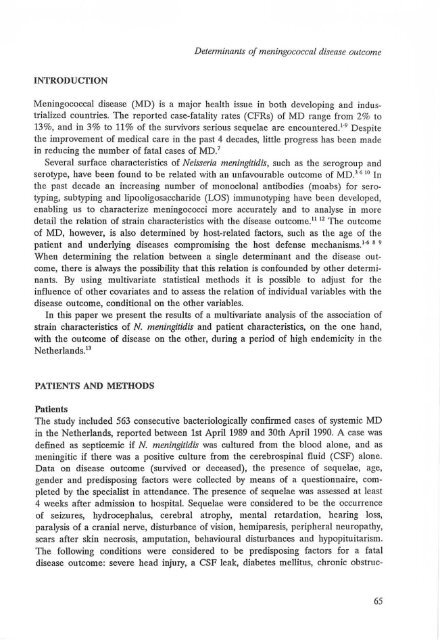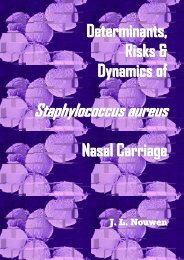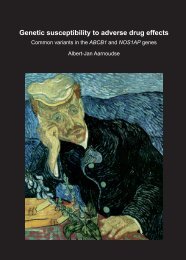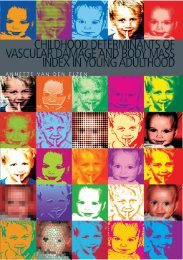An attempt at an epidemiological explanation - Epib.nl
An attempt at an epidemiological explanation - Epib.nl
An attempt at an epidemiological explanation - Epib.nl
- No tags were found...
You also want an ePaper? Increase the reach of your titles
YUMPU automatically turns print PDFs into web optimized ePapers that Google loves.
Determin<strong>an</strong>ts of meningococcal disease outcomeINTRODUCfIONMeningococcal disease (MD) is a major health issue io both developing aod indu strialized countries. The reported case-f<strong>at</strong>a lity r<strong>at</strong>es (CFRs) of MD r<strong>an</strong>ge from 2% to13%, aod in 3% to 11% of the survivors serious sequelae are encountered.'·' Despitethe improvement of medical care in the past 4 decades, little progress has been madein reducing the number of f<strong>at</strong>al cases of MD.'Several surface characteristics of Neisseria meningitidis, such as the serogroup <strong>an</strong>dserotype, have been found to be rel<strong>at</strong>ed with <strong>an</strong> unfavourable outcome of MD. 36 LO Inthe past decade <strong>an</strong> increasing number of monoclonal <strong>an</strong>tibodies (moabs) for seretyping, subtyping <strong>an</strong>d lipooligosaccharide (LOS) immunotyping have been developed,enabling us to characterize meningococci more accur<strong>at</strong>ely <strong>an</strong>d to <strong>an</strong>alyse in moredetail the rel<strong>at</strong>ion of strain characteristics with the disease outcome. 1L 12 The outcomeof MD, however, is also determined by host-rel<strong>at</strong>ed factors, such as the age of thep<strong>at</strong>ient <strong>an</strong>d underlying diseases compromising the host defense mech<strong>an</strong>isms. '·" 9When determining the rel<strong>at</strong>ion between a single determin<strong>an</strong>t <strong>an</strong>d the disease outcome,there is always the possibility th<strong>at</strong> this rel<strong>at</strong>ion is confounded by other determ in<strong>an</strong>ts. By using multivari<strong>at</strong>e st<strong>at</strong>istical methods it is possible to adjust for theinfluence of other covari<strong>at</strong>es <strong>an</strong>d to assess the rel<strong>at</strong>ion of individual variables with thedisease Oll tcome, conditional on the other variables.In this paper we present the results of a multivari<strong>at</strong>e <strong>an</strong>alysis of the associ<strong>at</strong>ion ofstrain characteristics of N. meningitidis <strong>an</strong>d p<strong>at</strong>ient characteristics, on the one h<strong>an</strong>d,with the outcome of disease on the other, during a period of high endemicity in th eNetherl<strong>an</strong>ds."PATIENTS AND METHODSP<strong>at</strong>ientsThe study included 563 consecutive bacteriologically confirmed cases of systemic MDin the Netherl<strong>an</strong>ds, reported between 1st April 1989 <strong>an</strong>d 30th April 1990. A case wasdefined as septicemic if N. meningitidis was cultured from the blood alone, <strong>an</strong>d asmeningitic if there was a positive culture from the cerebrospinal fluid (CSF) alone.D<strong>at</strong>a on disease outcome (survived or deceased), the presence of sequelae, age,gender <strong>an</strong>d predisposing factors were collected by me<strong>an</strong>s of a qu estionnaire, corn·pleted by the specialist in <strong>at</strong>tend<strong>an</strong>ce. The presence of sequelae was assessed <strong>at</strong> least4 weeks after admission to hospital. Sequelae were considered to be the occurrenceof seizures, hydrocephalus, cerebral <strong>at</strong>rophy, mental retard<strong>at</strong>ion, hearing loss,paralysis of a cr<strong>an</strong>ial nelVe, disturb<strong>an</strong>ce of vision, hem iparesis, peripheral neurop<strong>at</strong>hy,scars after skin necrosis, amput<strong>at</strong>ion, behavioural disturb<strong>an</strong>ces <strong>an</strong>d hypopituitarism.The following conditions were considered to be predisposing factors for a f<strong>at</strong>aldisease outcome: severe bead injury, a CSF leak, diabetes mellitus, chronic obstruc-65









